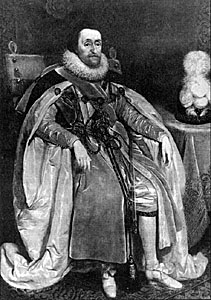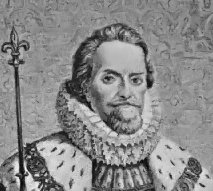
 ames I of
England and VI of Scotland (1566-1625), son of Mary Queen of
Scots and Lord Darnley, and grandson of James V, was born in
Edinburgh Castle. On the death of Queen Elizabeth in 1603, James
became the king of England and Ireland. His view that he held the
kingship by divine right, his impression that Puritanism was the
same as Presbyterianism, his wish to tolerate the Roman Catholics,
and his determination to exercise absolute power over Parliament,
led to conflicts with the House of Commons which continued
throughout his reign. From 1612 to 1628 he made strenuous efforts
to bring about a marriage between the Infanta of Spain and his
son Prince Charles, hoping thereby to secure the peace of Europe.
He had already, by his Ulster settlement, begun in 1607,
attempted to give peace to Ireland. But the native Irish disliked
the settlement, and were not conciliated; and in 1618, the Thirty
Years War broke out, and all hopes of the Spanish match were
destroyed. Hoping by diplomacy to secure the restoration of
Frederick to the palatinate, James sent Prince Charles and the
Duke of Buckingham to Spain. The mission having failed, James
made a treaty with Denmark, and arranged a marriage alliance with
France. James was known as a good scholar though somewhat
pedantic and was so desirous of preserving peace that a
vacillating policy made him more or less an object of contempt. [World
Wide Illustrated Encyclopedia, 1935]
ames I of
England and VI of Scotland (1566-1625), son of Mary Queen of
Scots and Lord Darnley, and grandson of James V, was born in
Edinburgh Castle. On the death of Queen Elizabeth in 1603, James
became the king of England and Ireland. His view that he held the
kingship by divine right, his impression that Puritanism was the
same as Presbyterianism, his wish to tolerate the Roman Catholics,
and his determination to exercise absolute power over Parliament,
led to conflicts with the House of Commons which continued
throughout his reign. From 1612 to 1628 he made strenuous efforts
to bring about a marriage between the Infanta of Spain and his
son Prince Charles, hoping thereby to secure the peace of Europe.
He had already, by his Ulster settlement, begun in 1607,
attempted to give peace to Ireland. But the native Irish disliked
the settlement, and were not conciliated; and in 1618, the Thirty
Years War broke out, and all hopes of the Spanish match were
destroyed. Hoping by diplomacy to secure the restoration of
Frederick to the palatinate, James sent Prince Charles and the
Duke of Buckingham to Spain. The mission having failed, James
made a treaty with Denmark, and arranged a marriage alliance with
France. James was known as a good scholar though somewhat
pedantic and was so desirous of preserving peace that a
vacillating policy made him more or less an object of contempt. [World
Wide Illustrated Encyclopedia, 1935]
Notes on James VI and I
He became King of Scots on 24 July 1567 as an infant on his
Mother’s abdication. He was crowned 29 July 1567 at Stirling.
On 24 March 1603, upon Queen Elizabeth’s death, he ascended
the throne of England as James the I of England. He was crowned
at Westminster on 25 July 1603. It has been suggested that his
father was not Darnley but Rizzio, his mother's Italian lover...
[GADD.GED]
 James I (of England)
(1566-1625), king of England (1603-25) and, as James VI, king of
Scotland (1567-1625).
James I (of England)
(1566-1625), king of England (1603-25) and, as James VI, king of
Scotland (1567-1625).
Born on June 19, 1566, in Edinburgh Castle, Scotland, James
was the only son of Mary, queen of Scots, and her second husband,
Lord Darnley. When Mary was forced to abdicate in 1567, he was
proclaimed king of Scotland. A succession of regents ruled the
kingdom until 1576, when James became nominal ruler. The boy king
was little more than a puppet in the hands of political
intriguers until 1581. In that year, with the aid of his
favorites, James Stuart, earl of Arran, and Esmé Stuart, duke of
Lennox, James assumed actual rule of Scotland. Scotland was at
that time divided domestically by conflict between the
Protestants and the Roman Catholics, and in foreign affairs by
those favoring an alliance with France and those supporting
England. In 1582 James was kidnapped by a group of Protestant
nobles headed by William Ruthven, earl of Gowrie, and was held
virtual prisoner until he escaped the next year.
In 1586, by the Treaty of Berwick, James formed an alliance
with his cousin, Queen Elizabeth I of England, and the following
year, after the execution of his mother, he succeeded in reducing
the power of the great Roman Catholic nobles. His marriage to
Anne of Denmark in 1589 brought him for a time into close
relationship with the Protestants. After the Gowrie conspiracy of
1600, James repressed the Protestants as strongly as he had the
Catholics. He replaced the feudal power of the nobility with a
strong central government, and maintaining the divine right of
kings, he enforced the superiority of the state over the church.
In 1603 Queen Elizabeth died childless, and James succeeded
her as James I, the first Stuart king of England. In 1604 he
ended England's war with Spain, but his tactless attitude toward
Parliament, based on his belief in divine right, led to prolonged
conflict with that body. James convoked the Hampton Court
Conference (1604), at which he authorized a new translation of
the Bible, generally called the King James Version. His undue
severity toward Roman Catholics, however, led to the abortive
Gunpowder Plot in 1605. James tried unsuccessfully to advance the
cause of religious peace in Europe, giving his daughter Elizabeth
in marriage to the elector of the Palatinate, Frederick V, the
leader of the German Protestants. He also sought to end the
conflict by attempting to arrange a marriage between his son,
Charles, and the infanta of Spain, then the principal Catholic
power. When he was rebuffed, he formed an alliance with France
and declared war on Spain, thus contributing to the flames he had
tried to quench. James I died at the Theobalds in Hertfordshire
on March 27, 1625, and was succeeded to the throne by his son,
Charles I. [Microsoft Encarta 98 Encyclopedia]
 Back
Back

 ames I of
England and VI of Scotland (1566-1625), son of Mary Queen of
Scots and Lord Darnley, and grandson of James V, was born in
Edinburgh Castle. On the death of Queen Elizabeth in 1603, James
became the king of England and Ireland. His view that he held the
kingship by divine right, his impression that Puritanism was the
same as Presbyterianism, his wish to tolerate the Roman Catholics,
and his determination to exercise absolute power over Parliament,
led to conflicts with the House of Commons which continued
throughout his reign. From 1612 to 1628 he made strenuous efforts
to bring about a marriage between the Infanta of Spain and his
son Prince Charles, hoping thereby to secure the peace of Europe.
He had already, by his Ulster settlement, begun in 1607,
attempted to give peace to Ireland. But the native Irish disliked
the settlement, and were not conciliated; and in 1618, the Thirty
Years War broke out, and all hopes of the Spanish match were
destroyed. Hoping by diplomacy to secure the restoration of
Frederick to the palatinate, James sent Prince Charles and the
Duke of Buckingham to Spain. The mission having failed, James
made a treaty with Denmark, and arranged a marriage alliance with
France. James was known as a good scholar though somewhat
pedantic and was so desirous of preserving peace that a
vacillating policy made him more or less an object of contempt. [World
Wide Illustrated Encyclopedia, 1935]
ames I of
England and VI of Scotland (1566-1625), son of Mary Queen of
Scots and Lord Darnley, and grandson of James V, was born in
Edinburgh Castle. On the death of Queen Elizabeth in 1603, James
became the king of England and Ireland. His view that he held the
kingship by divine right, his impression that Puritanism was the
same as Presbyterianism, his wish to tolerate the Roman Catholics,
and his determination to exercise absolute power over Parliament,
led to conflicts with the House of Commons which continued
throughout his reign. From 1612 to 1628 he made strenuous efforts
to bring about a marriage between the Infanta of Spain and his
son Prince Charles, hoping thereby to secure the peace of Europe.
He had already, by his Ulster settlement, begun in 1607,
attempted to give peace to Ireland. But the native Irish disliked
the settlement, and were not conciliated; and in 1618, the Thirty
Years War broke out, and all hopes of the Spanish match were
destroyed. Hoping by diplomacy to secure the restoration of
Frederick to the palatinate, James sent Prince Charles and the
Duke of Buckingham to Spain. The mission having failed, James
made a treaty with Denmark, and arranged a marriage alliance with
France. James was known as a good scholar though somewhat
pedantic and was so desirous of preserving peace that a
vacillating policy made him more or less an object of contempt. [World
Wide Illustrated Encyclopedia, 1935] James I (of England)
(1566-1625), king of England (1603-25) and, as James VI, king of
Scotland (1567-1625).
James I (of England)
(1566-1625), king of England (1603-25) and, as James VI, king of
Scotland (1567-1625).